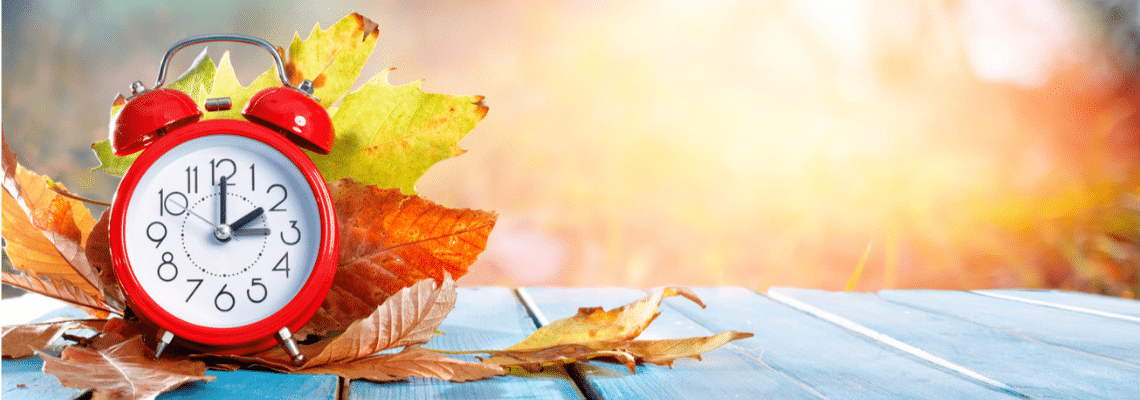
The time to fall-back with the end of Daylight Saving Time is upon us. On Sunday, November 4, 2018, we have to switch our clocks back an hour. The end of Daylight Saving Time is considered a time where we gain an hour, but however a baby’s internal clock is not tuned into to this change. In your everyday life Daylight Saving Time doesn’t usually have too much of an impact, however, once you become a parent you realize that is no longer the case. Luckily there are a few easy steps that you can take to help your baby adjust to the fall time change, without too much disruption.
Solid Sleep Foundation
It is important to keep in mind that every baby is different. Therefore, starting with a solid sleeping foundation is a good place to start. In order for a baby to have a solid sleep foundation they require three fundamental elements.
- Noise – While some babies enjoy lullabies, music, and ocean sounds to fall asleep to, most babies are actually more stimulated by a rumbly, deep brown noise. Brown noise is a deeper, stronger sound, at the low end of the spectrum without high frequency sounds.
- Dark – Your baby wants and needs their room to be dark for naps and a good night’s sleep. It should be dark enough so that the sun is not visible through the windows during the day. Blackout shades are a great way to make sure that the room is dark enough for naps during the day.
- Bedtime – Bedtime should occur between 6:30- 7:30 p.m. when the infants melatonin is at its peak. If you try to put a baby to sleep before or after this time, it might result in night wakings and or very early wake up times.
Keep Them in the Crib
It is best to try and keep your child in their crib until they are three years old. This is especially important for the fall time change. Once you put your child into a toddler bed this gives them the freedom to jump out of their beds and to roam the house when they wake up. Children under the age of three are not developed enough yet to understand that waking up before mom and dad and making a mess throughout the house is not the best choice during the first day of Daylight Saving Time. A crib will help to control your child’s movements, so that if they do wake up before their normal time they are in a safe place until you are up to help them.
Different Types of Sleepers Will Require Different Levels of Help
 A Strong Sleeper
A Strong Sleeper
If your baby is a strong sleeper already, getting about 11-12 hours of sleep a night and a few hours of a nap a day, then you don’t need to do much before Daylight Saving Time to prepare them. If this is the case, your baby will need around five days to adjust to the time change. Your baby will probably wake up an hour earlier on the morning of Daylight Saving Time. If this is the case, try to wait thirty minutes before going to get your baby from their crib. This will help to make sure that your baby’s sleep cycle does not fall apart from the time change. Try and keep the rest of your schedule that day pushed back by 30 minutes. Naps, eating, bath, and bedtime should now be 30 minutes later than normal. After three days of pushing everything back by 30 minutes, push the new schedule back again by 30 more minutes. This will now put you on the same schedule that you were on before Daylight Saving Time without much disruption.
A Problem Sleeper
If your baby is having problems sleeping through the night than you will need to be proactive for the time change to help keep your baby from a regression in their sleeping patterns. You should start this process one week prior to Daylight Saving Time. One week before, adjust the baby’s bedtime to be 15 minutes later than normal. In the morning let your baby stay in their crib for 15 minutes after they wake up before going to get them. Like with a strong sleeper, you will want to push your entire day’s schedule back by 15 minutes. Naps, eating, bath, and bedtime should now all be 15 minutes later. After two days have passed, add another 15 minute push to the new schedule. Now, everything has been pushed back a total of 30 minutes from when you began. Continue this process every two days pushing your schedule back by 15 minutes, until you get to your normal schedule right around Daylight Savings Time. If your baby is resisting the small time changes, try to give them an extra day to adjust, therefore turning two days into three.
Extra Help
If your baby suffers from a sleep regression from Daylight Saving Time, it can negatively impact the sleep pattern of your entire family. If your baby is struggling to find a good sleeping pattern there are steps you can try to take to help them with this process. If your baby is still having trouble with the transition, it may be time to find a sleep or parenting expert to help.
Things to Keep in Mind
It is important to keep in mind that every baby is different. It may take some babies extra time to adjust to the new schedule. A newborn under 12 weeks old may not follow these same adjustments due to developmental reasons. This guide is for children three months to three years old.
Daylight Saving Time may seem like not much of a difference in time as an adult, but for children this hour can take a lot to adjust to.


